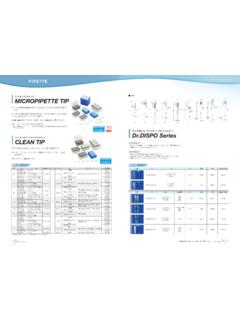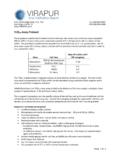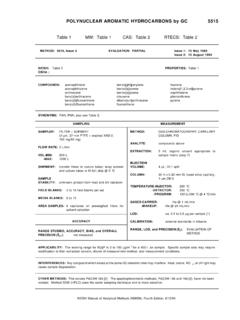Transcription of Lesson II Alcohol Dehydrogenase Assay (estimated …
1 1 Lesson II Alcohol Dehydrogenase Assay ( estimated duration 1-2 hours) Table of Contents I. Pre-requisite knowledge 2 II. Massachusetts Science and 2 Technology/Engineering Frameworks Compliance III. Content to be Taught 2-3 IV. Rationale 3 V. Goals 3 VI. Objectives 3 VII.
2 Background for Teacher 4-5 VIII. Materials 5 IX. Engagement 6 X. Exploration 1: Enzyme Activity 7 XI. Exploration 2: ADH Lab 7-12 XII. Explanation 12-13 XIII.
3 Evaluation 13 XIV. ADH Lab Prep 14-18 2 Lesson II Alcohol Dehydrogenase Assay Outline I. Pre-requisite knowledge A. Students should be familiar with the basic concepts of graphing, specifically X- and Y- axis location, axis labeling, creating a scale, and graph interpretation. B. Students should be familiar with proper handling and use of a p200 micropipette. II. Massachusetts Science and Technology/Engineering Frameworks Compliance Bio : Explain the role of enzymes as catalysts that lower the activation energy of biochemical reactions.
4 Identify factors, such as pH and temperature, that have an effect on enzymes. SIS1: Observe the world from a scientific perspective. SIS1: Pose questions and form hypotheses based on personal observations. SIS2: Articulate and explain the major concepts being investigated and the purpose of the investigation. SIS2: Select required materials, equipment, and conditions for conducting an experiment. SIS2: Identify independent and dependent variables. SIS2: Employ appropriate methods for accurately and consistently: -making observations. -making and recording measurements at appropriate levels of precision. -collecting data or evidence in an organized way. SIS2: Properly use instruments, equipment, and materials ( , scales, probeware, meter sticks, microscopes, computers) including set-up, calibration (if required), technique, maintenance, and storage.
5 SIS4: Review information, explain statistical analysis, and summarize data collected and analyzed as the result of an investigation. SIS4: Explain diagrams and charts that represent relationships of variables. SIS4: Construct a reasoned argument and respond appropriately to critical comments and questions. III. Content to be Taught A. The liver processes Alcohol that enters the body s digestive tract. B. Rates of enzyme activity can be concentration-dependent and have maximum values. 3 C. Alcohol Dehydrogenase is an enzyme in the human body that breaks down Alcohol to acetylaldehyde, NADH, and hydrogen ions. D. Alcohol Dehydrogenase requires the coenzyme NAD+ in order to function. E. Addition of PMS in the Assay will create a color reaction, and resulting color intensity will be proportional to the amount of NADH produced in the reaction.
6 Since the amount of NADH produced is proportional to the amount of Alcohol broken down, the color intensity indicates the amount of Alcohol broken down. F. A spectrophotometer is an instrument that can quantify color by measuring the amount of light it absorbs. The amount of light a solution absorbs is proportional to the intensity of its color, , how dark it is. G. As substrate concentration ( Alcohol ) increases, overall enzyme activity rate increases to keep up. In our Assay , substrate is ethanol ( Alcohol ) and enzyme is ADH. H. The amount of enzyme is not always sufficient for the amount of Alcohol to be broken down. If the enzyme cannot keep up, unprocessed Alcohol will accumulate in the body. I. Accumulation of excess Alcohol can be seen in the graph as the straight line (labeled increasing Alcohol concentration cf.)
7 Page 5) when it has diverged from the Alcohol catabolism curve. IV. Rationale In this Lesson , students will learn about the breakdown of Alcohol in the body and how enzymes work to perform this process. By performing the lab procedure and analyzing the resulting graph, students discover that enzymes cannot always keep up with their substrates and as a consequence Alcohol accumulates in the body. Lastly, this Lesson develops students skills to follow a laboratory protocol, use a micropipette, measure solutions using a spectrophotometer, and graph, analyze, and interpret lab-derived data. V. Goals Students will understand that Alcohol Dehydrogenase is an enzyme that breaks down ingested Alcohol in the body, and that this enzyme cannot always keep up with the amount of Alcohol (substrate) present.
8 Students will learn this by analyzing the graph of their lab data showing that the rate of Alcohol breakdown, and therefore overall enzyme activity, levels off as Alcohol concentration in the body continues to increase (as one drinks more). Lastly, students will predict that unprocessed Alcohol accumulates in the body. VI. Objectives A. Predict how Alcohol is broken down B. Learn to use p200 micropipettes. C. Perform an Alcohol Dehydrogenase Assay . D. Graph experimental data and interpret findings 4 VII. Background for Teacher A. ADH and the liver Alcohol Dehydrogenase (ADH) is an enzyme that functions in the liver to break down, or catabolize, Alcohol . Other functions of the liver are to produce substances that break down fats, convert glucose to glycogen, produce urea (the main substance of urine), and make certain amino acids (the building blocks of proteins).
9 REFERENCE: B. Mechanism of action of ADH Alcohol Dehydrogenase catalyses the oxidation of ethanol to acetaldehyde in the presence of the coenzyme nicotinamide adenine dinucleotide (NAD+), according to the following chemical reaction: Alcohol Dehydrogenase CH3CH2OH + NAD+ ---------------------------------------- -> CH3CH=O + NADH + H+ (ethanol) (acetaldehyde) REFERENCE: ~chm/ C. Alcohol Dehydrogenase Assay The enzymatic activity of Alcohol Dehydrogenase can be assayed spectrophotometrically according to a standard Assay generally used for all NAD+ -dependent oxidoreductases, which reduce NAD+ to NADH. This reduction of NAD+ is accompanied by a change in absorption of the NAD+ molecule and thus can be followed spectrophotometrically at 340nm in real time.
10 According to the Lambert-Beer law, the extinction of NAD+ is proportional to its concentration. The change in concentration of NAD+ over time will allow the calculation of the activity of Alcohol Dehydrogenase in the solution, using the following unit definition for Alcohol Dehydrogenase : One unit will convert mole of ethanol to acetaldehyde per minute at pH at 25oC. Therefore, one unit will also convert mole of NAD+ to NADH per minute. REFERENCE: K gi, and Vallee, (1960) Journal of Biological Chemistry 235, 3188-3192 D. Explanation When the rate of Alcohol catabolism cannot keep up with increases in Alcohol concentration, unprocessed Alcohol begins to accumulate in the system. If the line of constant increasing Alcohol concentration is overlaid on an Alcohol catabolism curve, this accumulation of Alcohol can easily be seen by the separation of the two graphs and is indicated by the dotted line in the graph below.







